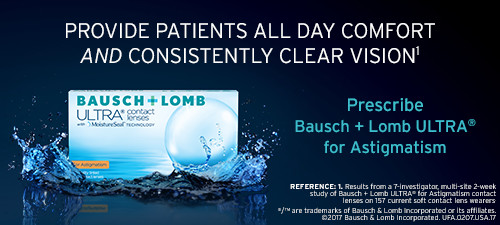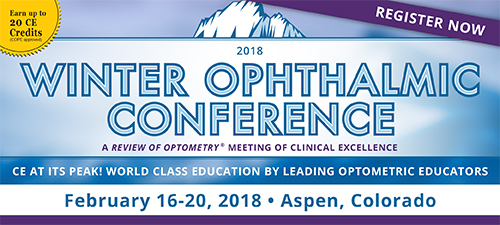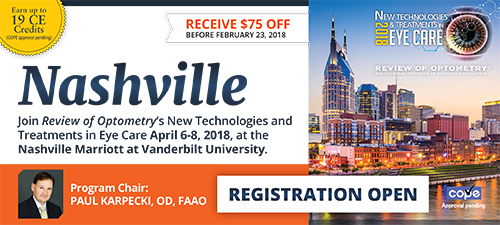
A
weekly e-journal by Art Epstein, OD, FAAO
Off the Cuff: The FTC – What They Don’t Know Will Hurt Consumers
In a few short weeks the FTC will be meeting to decide the fate of the contact lens industry and, perhaps inadvertently, the health and well-being of every contact lens wearer in the U.S. Focused on consumer rights at the expense of public safety, the FTC will be considering needless and resource-consuming new contact lens documentation requirements. It is also expected to propose generic lens substitution regulation. In this process, the FTC will have ignored the complexity of contact lens materials, the differences between contact lens designs and, most importantly, the sometimes-devastating reality that contact lenses are medical devices that, when misused or improperly fitted, can cause life-changing harm to wearers.
|
|||||
 |
||
| Determinants of the Frequency of Contact Lens Wear | ||||
Survey forms were sent to contact lens fitters in up to 40 countries between January and March for five consecutive years (2007 to 2011) to characterize and discover the determinants of the frequency of wear (FOW) of contact lenses. Practitioners were asked to record data relating to the first 10 contact lens fits or refits performed after receiving the survey form. Only data for daily wear lens fits were analyzed. Data were collected in relation to 74,510 and 9,014 soft and rigid lens fits, respectively. Overall, FOW was 5.9±1.7 days per week (DPW). Researchers reported that, when considering the proportion of lenses worn between one and seven DPW, the distribution for rigid lenses was skewed toward full-time wear (seven DPW), whereas the distribution of soft daily disposable lenses was possibly bimodal, with large and small peaks at seven and two DPW, respectively. There was significant variation in FOW among nations, ranging from 6.8±1.0 DPW in Greece to 5.1±2.5 DPW in Kuwait. For soft lenses, FOW increased with decreasing age. Females (6.0±1.6 DPW) wore lenses more frequently than males (5.8±1.7 DPW). FOW was greater among those wearing presbyopic corrections (6.1±1.4 DPW) compared with spherical (5.9±1.7 DPW) and toric (5.9±1.6 DPW) designs. FOW with hydrogel peroxide systems (6.4±1.1 DPW) was greater than that with multipurpose systems (6.2±1.3 DPW). Numerous demographic and contact lens-related factors impacted FOW. Researchers suggested that there might be a future trend toward a lower FOW associated with the increasing popularity of daily disposable lenses. |
||||
SOURCE: Morgan PB, Efron N, Woods CA, et al. Determinants of the frequency of contact lens wear. Eye Contact Lens. 2013;39(3):200-4. |
||||
|
|||
| The Risk of Blepharoptosis in Contact Lens Wearers | ||||
The aim of this systematic review was to summarize and evaluate the risk of blepharoptosis in contact lens wearers. In a PubMed search, 393 papers were found using the terms "lens and ptosis."
The abstracts were read, and 16 full text articles were reviewed. Among these, five articles were analyzed. Five studies were subgrouped, and a meta-analysis of related data suggested an increased risk of blepharoptosis in hard contact lens wearers over nonwearers (n = 7426; OR, 17.38, 95% CI = 3.71-81.29, p < 0.00001). One study was subgrouped, and the data suggested an increased risk of blepharoptosis in soft contact lens wearers over nonwearers (n = 90; OR, 8.12, 95% CI = 2.68-24.87, p < 0.0002). Authors wrote that patients wearing rigid contact lenses should be advised of the risk of ptosis, and a history of contact lens use should be sought in all patients who have acquired ptosis, as other authors also have recommended. |
||||
SOURCE: Hwang K, Kim JH. The risk of blepharoptosis in contact lens wearers. J Craniofac Surg. 2015;26(5):e373-4. |
||||
|
|||
| Allergic Manifestations of Contact Lens Wearing | ||||
Contact lens-induced papillary conjunctivitis (CLPC) is a common ocular allergic disease in contact lens wearers, authors wrote. In its more severe form, it can cause giant papillary conjunctivitis, resulting in contact lens intolerance and the need to discontinue the use of contact lenses. This review presented the pathogenesis, clinical manifestations and management guidelines of the common disorder.
Different types of contact lenses are associated with differences in the severity of CLPC. Refitting patients with silicone hydrogel contact lenses or with daily disposable contact lenses may improve the signs and symptoms of CLPC, authors wrote. The recent introduction of the topical immunomodulatory agent tacrolimus in other severe allergic eye diseases may aid in suppressing the allergic inflammation in CLPC as well, they added. CLPC has a significant impact on the quality of vision, and should be promptly recognized by healthcare practitioners and managed by modifications of the types and wearing schedules of contact lenses, as well as novel treatment options with topical immunomodulators, authors recommended. |
||||
SOURCE: Solomon A. Allergic manifestations of contact lens wearing. Curr Opin Allergy Clin Immunol. 2016;16(5):492-7. |
||||
| News & Notes | ||||||||
| ReVision Optics, Manufacturer of Raindrop Near Vision Inlay, Closing ReVision Optics, the maker of the Raindrop Near Vision Inlay, announced it is shutting down operations. A statement on the company’s website says the company “…made great strides to build a market for the surgical correction of presbyopia, but respectful of our best efforts, it is with regret, that we have to close our doors. The Raindrop Inlay will not be sold to ophthalmic practices or distributors as of Tuesday, January 30, 2018. As a result, the Raindrop Rebate will not be honored past this date…. It has been a privilege to have the opportunity to bring Raindrop Inlay to the presbyopic community and innovative ophthalmic practices.” The company instructs questions to a hotline number (1-866-934-6592), which will be staffed through April 30. Approved by the FDA in June 2016, the corneal reshaping inlay was made of a hydrogel material and inserted under a flap, similar to LASIK. About 2mm in diameter, 30µm thick and made of approximately 80% water, the inlay was the same refractive index as the cornea. When placed in the cornea, it changed the shape of the central cornea, simulating a multifocal contact lens. Read more. |
||||||||
| OCuSOFT Launches OCuSOFT UK OCuSOFT announced that Scope Ophthalmics no longer offers OCuSOFT products and that OCuSOFT Lid Scrub Original and Lid Scrub Plus products will now be available directly from OCuSOFT UK. General inquiries regarding Lid Scrub products should be directed to ocusoft@ocusoft.com. Orders and inquiries can also be directed to Trevor McCormack, managing director, OCuSOFT UK at: +44 12150619073. McCormack, co-founder of MacuShield, has longstanding relationships in the eye care industry that will enhance customer service. The OCuSOFT UK website is under construction and will be announced in upcoming weeks. Read more. |
||||||||
| Eyepromise Introduces Improved Formula of Restore Ocular Nutritional Supplements EyePromise announced the introduction of an improved formula for its EyePromise Restore line, with the addition of vitamins B6 and B12, folic acid and Coenzyme Q10. The Restore ocular nutrition supplement is specially formulated to preserve and support vision for individuals concerned with, at-risk for or in the early stages of age-related macular degeneration. In an article published in Advances in Ophthalmology& Visual System, the authors reported that 97.8% of individuals supplementing with the original Restore formulation improved or stabilized AMD progression, and 88.3% saw at least a 30% increase in macular pigment optical density. Read more. |
||||||||
| InFocus Completes Series A Investment in Qura InFocus Capital Partners provided a Series A round of funding for Qura to advance the QSmart wireless, implantable pressure sensor technology and monitoring system. QSmart assists in glaucoma management by providing 24/7 monitoring, pressure-event detection and real-time intraocular pressure updates. Information from this micro-sized wireless implantable device is delivered to a handheld device or tablet, enabling physicians to evaluate the effectiveness of glaucoma treatment for patients. Read more. |
||||||||
| Imprimis Makes Available Two Glaucoma Drugs on FDA Drug Shortage List; Cosopt PF Manufacturer Assures That Drug is Widely Available Imprimis Pharmaceuticals is dispensing preservative-free dorzolamide and a preservative-free dorzolamide/timolol formulation after dorzolamide and the commercial products, Cosopt and Cosopt PF, were added to the FDA drug shortage list. Imprimis’ preservative-free compounded formulations are available in all states and Puerto Rico. The company will not dispense the formulations with preservatives such as benzalkonium chloride. Read more. At the same time, the manufacturer of Cosopt PF (dozolamide HCl-timolol maleate ophthalmic solution) 2%/0.5%, Akorn Pharmaceuticals, wants to assure the clinical community that, though there is a shortage of two generic versions of the active ingredients in Cosopt, Cosopt PF itself is widely available and in stock at pharmacies for patients. Cosopt PF is the preservative-free form of Cosopt and is packaged in cartons of 60 single-use vials. Cosopt PF NDC # is 17478-0604-30. Read more. |
||||||||
NORA Appoints Esterow as Executive Director
|
||||||||
|
||||||||
|
||||||||
|
||||||||
|
||||||||
|
Optometric Physician™ (OP) newsletter is owned and published by Dr. Arthur Epstein. It is distributed by the Review Group, a Division of Jobson Medical Information LLC (JMI), 11 Campus Boulevard, Newtown Square, PA 19073. HOW TO ADVERTISE |





